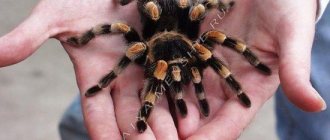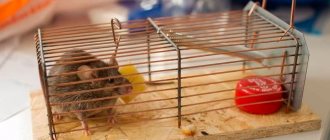Mice cause people a lot of trouble - they eat and spoil food, chew wires, furniture, even clothes and shoes. But the most serious threat of rodents is that they are carriers of pathogens of many infectious diseases that can infect people and pets.
To prevent this from happening, it is very important to start fighting mice as soon as the first signs of their presence are detected.
Types of diseases carried by mice
A hundred years ago, when listing what diseases mice carry, it was impossible not to mention plague and typhus. Nowadays, these diseases are diagnosed extremely rarely, but the list of pathologies that can be contracted from rodents still includes many dangerous ones:
- mouse fever;
- salmonellosis;
- tularemia;
- leptospirosis;
- bartonellosis;
- rickettsiosis;
- pseudotuberculosis;
- rabies.
Rabies virus
In addition, mice are carriers of parasites, in particular tapeworms.
Hemorrhagic fever
Mouse disease or hemorrhagic fever with renal syndrome is a disease that people contract by inhaling dust containing mouse secretions. Less commonly, infection occurs through contact with the rodents themselves or by eating food spoiled by them. More often than others, mouse fever is infected by people engaged in agriculture (digging or cultivating the land, working with hay, mixed feed), dismantling dilapidated buildings, carrying out dry cleaning in premises where rodents lived - carriers of the disease.
The disease is characterized by an acute onset:
- heat;
- headache;
- nausea, vomiting;
- lower back pain.
After 2-3 days, severe weakness, insomnia, bleeding, and rash are added to these symptoms. The virus affects the kidneys, so there is pain when urinating and a decrease in the amount of urine. Without treatment, the patient faces complications: hemorrhages in internal organs, kidney failure, kidney rupture, cerebral or pulmonary edema.
Salmonellosis
Among the diseases that mice carry, one of the most common is salmonellosis. The disease is caused by salmonella - bacteria that, when entering the body, cause severe intoxication and the development of an inflammatory process in the gastrointestinal tract.
In rodent excrement, Salmonella retains its properties for up to 4 years. Therefore, in order to become infected with salmonellosis, a person does not necessarily have to come into contact with mice. It is enough to eat a product contaminated with mouse feces.
The main signs of salmonellosis:
- elevated temperature;
- vomit;
- diarrhea;
- sharp pain in the abdominal area;
- cardiopalmus.
Salmonella
The danger of the disease is that without treatment, liver or heart failure, as well as infectious-toxic shock, can develop quite quickly.
Tularemia
Another dangerous thing about mice is that their bodies are parasitized by blood-sucking insects, in particular fleas. They are the ones who can infect a person with an infectious disease such as tularemia. Bacteria that cause the disease are found in the blood of an infected animal. A flea or tick bites a sick rodent and then bites a person, infecting him. Less commonly, you can become infected through contaminated food or when the infection gets into an open wound or mucous membrane.
In addition to high fever, headaches and weakness, tularemia is characterized by enlarged lymph nodes, muscle pain, and difficulty breathing. If the cause of infection is a tick or flea bite, an ulcer will soon form at the site of the bite.
Leptospirosis
Leptospirosis is one of the diseases caused by bacteria. The pathogen is found in the urine of rodents, so it enters the human body either with food, or when washing with infected water, or when swimming in an open body of water.
The first symptoms of illness appear after a couple of weeks. The patient's temperature quickly rises, his head and joints hurt badly, and his sleep is disturbed. There is severe pain in the thigh and calf muscles, the face swells and turns red.
Without treatment, leptospirosis can lead to hepatitis, impaired renal function, and less commonly, meningitis.
Bartonellosis
Rodents are carriers of several types of Bartonella bacteria, which, when entering the body, cause the development of bartonellosis. The bacteria are transmitted from an infected mouse either through the bite of a blood-sucking tick, flea or louse, or through a fresh break in the skin. The most common signs of the disease:
- general malaise;
- heat;
- nausea, vomiting;
- swelling of the lymph nodes;
- skin hemorrhages;
- joint pain;
- chest pain.
Not only people, but also pets can become infected with bertonellosis. Therefore, it is very important to regularly visit the veterinarian with a cat or dog that preys on rodents.
Rickettsial disease
Rickettsial disease or murine typhus is another rodent-borne disease. It is caused by bacteria of the genus Rickettsia. They can enter the human body by eating foods containing mouse droppings or through the bites of blood-sucking parasites. A less common route is inhaling dust containing feces from fleas that have bitten infected mice.
The main symptoms of murine typhus:
- temperature increase;
- chills;
- pain in muscles and joints.
Mouse in the house
4-5 days after the onset of the disease, pink rashes may appear on the face, feet and palate. With timely treatment, the prognosis is favorable.
Yersiniosis
Yersiniosis is a disease transmitted to humans through rodent excrement. With them, the bacteria Yersinia enterocolitica enters the body, affecting the liver, heart, intestines, and musculoskeletal system. The symptoms of the disease are very diverse, which makes diagnosis difficult. Most common symptoms:
- fever;
- headache;
- weakness;
- muscle pain;
- nausea, vomiting;
- stomach ache;
- rash in the form of bumps or spots;
- pain when urinating.
Yersiniosis is dangerous due to the frequent development of complications, including peritonitis, sepsis, and intestinal obstruction.
Pseudotuberculosis
This disease is transmitted to humans through contact with mouse excrement. You can become infected by eating raw vegetables from a vegetable store where rodents live, or by drinking water from an open reservoir. With pseudotuberculosis, the infection affects the liver and intestines. The first symptoms are atypical, these are:
- fever;
- intoxication;
- skin rashes;
- redness of the face and neck;
- joint and muscle pain;
- decreased appetite.
Pain and sore throat and runny nose are less common. Without treatment, the pathology provokes the development of polyarthritis, osteomyelitis, and pneumonia.
Tapeworms
What else you can get infected from mice are various parasites. Most often these are tapeworms that enter the human body with mouse droppings (from unwashed hands, vegetables or fruits, cereals and other products).
Main symptoms:
- headache;
- increased salivation;
- nausea;
- rash accompanied by itching;
- digestive problems, exhaustion;
- development of allergies.
Most often, the disease affects people working in bakeries and granaries.
Rabies
Mice are carriers of rabies, but people rarely get infected from them. The pathogen is transmitted through the saliva of an infected rodent, and once in the body it affects the nervous system and brain.
Attention! Rabies is a deadly disease.
A favorable prognosis is possible only if treatment is started in a timely manner.
For what reasons are mice attacked by rats?
It is extremely easy to distinguish one species from another, and the main factor is size. Large predators sometimes grow up to 30 cm in body length, and the parameters of mice do not exceed 10 cm. That is why smaller brothers try, if possible, not to come into contact with aggressive rodents. There is no open hostility between representatives and rats will not attack without a clear reason. Among the main factors of aggression it is worth highlighting:
- Hunger;
- Protection;
- The emergence of competition;
- Active population expansion and competition for territory.
Hunger forces species of wild rats to do absolutely desperate things and even eat their relatives. At least, in a critical situation, pests will definitely not disdain to feast on a mouse. A dead animal automatically becomes potential food. Even if a large rodent is not hungry, it will take the prey it finds with it as a reserve.
Rats are remarkably aware that they are capable of a level higher than mice. Small representatives of the species that accidentally find themselves in enemy territory will be immediately killed and eaten. This aspect is direct evidence of competition. Mice that deliberately visit rat colonies to steal food are completely doomed to die.
Among the small animals there are also brave individuals that will attack large predators. Of course, the rat will not disdain the opportunity to kill the daredevil and feast on the best source of animal protein.
Aggressors also eat weak mice, but they show particular aggression when exploring new territories. Rats reproduce quite quickly and try to find a favorable area to live. Rodents that don't want to leave and choose to fight are likely to die. From the factors described above, it is quite easy to conclude that rats are hostile. According to the laws of nature, the strongest survive, which is clearly proven by such large individuals.
Methods of transmission of diseases from mice
There are several possible ways of contracting infectious diseases from rodents. The vast majority of them occur after contact with the mouse itself or the results of its vital activity.
Access to food
Transfer methods:
- bites and scratches received from rodents;
- insect bites that parasitize mice;
- eating foods chewed by mice or contaminated with their excrement;
- contact of mouse feces on mucous membranes or open wounds;
- direct contact with the corpse of a rodent;
- by inhaling dust containing mouse hair and droppings.
Pet owners who actively hunt rodents who are wondering whether it is possible to catch mouse fever or another disease from a cat can be reassured that fever cannot be passed on to humans from a pet. But diseases transmitted, for example, by a flea bite, can pass to a cat, and from it to a person (and often with the insect itself).
Bats: to eat or not to eat?
By the way, about the culinary component. When we imagine that bats are eaten, most often the average person has the image of a tiny bat in which, like a sparrow, there is nothing to eat. But the order of bats is very diverse and numbers more than 1,300 species. Chiropterans inhabit the entire planet, excluding the Arctic and Antarctica. Just as bats are diverse, so is the cuisine... Of course, large species are eaten as food.
I have long noticed that the passion for eating everything that moves is inherent in countries where in some historical periods there was simply nothing to eat. And then, in the well-fed years, these dishes entered restaurant menus as a delicacy. I hope you don’t think that the French initially began to eat frog legs out of a well-fed life in search of something exclusive. No, they started eating them in search of protein food. Snails and onion soup are from the same times of the Hundred Years War, which, as you know, lasted not a hundred years.
However, let's return to bats. Of course, bats live where it is warm and cozy, and when it is cold, they hibernate, which can last about 6 months. Here you can remember Bram Stoker and his novels about vampires who turn into a bat. But there is no smoke without fire - the Desmodidae family, indeed, feeds by hematophagy - drinks the blood of warm-blooded animals, not disdaining sleeping people.
Chiropterans, primarily bats, have been the object of religious superstitions in Western Europe for a long time. The Catholic Church has traditionally portrayed them as the classic retinue of witches and warlocks.
The bat's furry body resembles that of a rat or mouse. The leathery membranes of the wings are stretched over a frame resembling the spokes of an umbrella, large translucent ears with cartilaginous thickenings and clearly visible blood vessels, a pig-like snout with bristling bristles, a habit of sleeping upside down, claws hooked on the arches of a cave immersed in darkness.
Bat dishes are also known in the southern regions of China. Thus, in Cantonese cuisine, fruit bat meat is considered an exotic dish.
I remain of the opinion that chiropteran meat is simply a cheap alternative to expensive meat, and in second place is culinary traditions and an attraction for tourists.
Mice are also famous for the fact that their droppings, which are scraped off rocks by enthusiasts, are called mummies. They are smeared with it and eaten with milk and honey. Who likes what more...
In addition to culinary exoticism, mice also provide benefits. It turns out that they have amazing immunity, which is adapted to peaceful coexistence with various pathogens. This surprising resistance could form the basis of new research into antiviral drugs for humans, says Paul Webal, a senior lecturer at Kenya's Maasai Mara University.
But how, I wonder, do people manage to catch a bat? Actually, it's not difficult. It is enough to place several people with a fishing net at the exit of the cave in which the animals spend the day and from which, at dusk, thousands leave to feed. A person with a shotgun at this time has every chance of killing 20-30 bats with one shot. Only then will the cook have to remove all the pellets from the carcasses. You can put a net trap. You can catch it on a white duvet cover, where mice are usually stuffed in the Moscow region or in the south of Russia.
Failed to catch? Can buy!
Go to the market in any Asian country, they will sell you a ready-made gutted mouse.
How to cook?
Processing is reduced to the following operations: gutting, trimming the wings and head, singeing. But sometimes they put the whole thing in the soup, without peeling it, along with the skin. For example, in Fiji it is popular for the mouse to be boiled whole instead of with the skin. The dish is expensive, and we don’t understand this added value, but for the locals it is a real delicacy that few people can afford.
Wings are not eaten. Despite the visual volume, there is simply nothing to eat there. The wings have no weight - only light bone and membrane. But I am sure that the locals probably know how to make some kind of soup from them - after all, bones and collagen. They make soup from fins.
It is worth noting that for the average person all these animals are bats, but the large individuals that are most often eaten by residents of Asia, flying foxes, are a genus of bats of the fruit bat family (Pteropus seychellensis). Flying foxes are the largest representatives of bats. There are at least 60 extant species of flying foxes. They live in the tropics and subtropics of South and Southeast Asia, New Guinea, Oceania, Australia and Madagascar. In the Seychelles Islands, in the Indian Ocean, fruit bat (flying fox) meat, seasoned with curry, is one of the national and main dishes of Creole cuisine. The Seychelles flying fox is one of the most commonly eaten bats.
Here is an excellent video demonstrating the processing and preparation of bats in Indonesian cuisine:
If anyone decides to try it, share your impressions!
What to do if you are bitten?
Mice rarely attack people. These animals are shy and cautious, so they lead a secretive lifestyle and try to escape in case of danger. But in rare cases, an encounter with a rodent may result in it biting (for example, if you try to catch a mouse or pick up a trap with a rodent caught in it). If this happens, the victim must be given first aid:
- Rinse the wound thoroughly with clean water (or with laundry soap);
- disinfect the wound (hydrogen peroxide, alcohol, brilliant green, iodine, Miramistin);
- cover the wound with a plaster or bandage to avoid mechanical damage or secondary infection.
For several days it is necessary to carefully monitor the condition of the damaged area and general well-being. If you feel unwell after a mouse bite, and the wound does not heal or hurts, you should immediately consult a doctor in order to correctly diagnose and promptly begin treatment of the infectious disease.
Is it possible to stop eating mice?
Modern cats (with the exception of those who sit on pasture) have stopped eating caught mice: they are brought to their owners as proof of their dexterity and diligence, often in gratitude for human care. In addition, a cat will not eat a mouse if it has had enough to eat. If you don’t want your pet to eat rodents, watch the energy value of its usual food.
There is an option - to put on a collar with tiny bells: this way, the cat will not only not eat, but, above all, will not catch the mouse . A side effect is the annoying rattling of the bell, which not everyone can withstand. If your cat starts chasing mice at your dacha, build her an enclosure where she can frolic until the evening: in this case, all the day’s prey will remain in the enclosure, and you will take the cat into the house in the evening. This method is also not flawless - most personal plots are not designed for unplanned structures.
This is interesting! The most ingenious development is considered to be the development of one meticulous programmer, who came up with a compact automatic door for his cat named Squirrel. The guy got tired of bumping into cat trophies (strangled mice/birds in different corners of the apartment) and he designed a door that opened in front of the “empty” cat and did not open if he was holding something in his teeth.
The programmer taught the camera standing at the entrance to analyze the image (which was simultaneously broadcast to the web server), comparing it with a template, and make a decision about allowing the object into the house.
Those who are far from the world of computer technology can cope with the problem in a radical, albeit not entirely humane way, by once and for all banning their cat from going out into the yard.
Prevention of infection
You can become infected with an infectious disease from mice living in your home without even meeting them. Therefore, the most effective way to avoid infection is to kill rodents. In addition, the following recommendations will help to significantly reduce the risk of contracting an infection:
- it is necessary to properly store food and water so that rodents cannot get to them;
- vegetables and fruits brought from the basement must be thoroughly washed, peeled and it is better not to eat them raw;
- it is necessary to periodically inspect food supplies and throw away all products damaged by mice;
- You cannot catch live rodents or touch dead ones with your bare hands;
- You should not take wild rodents into your home in the hope of taming them;
- You should regularly clean the house (spring cleaning is especially important if the house has been closed for the winter);
- It is better to work in the area with gloves, and wash your hands thoroughly afterwards;
- when swimming in open waters, you should not take water into your mouth, much less swallow it;
- The garden plot must be kept clean and construction and plant debris must be removed in a timely manner.
Vegetables, berries, and herbs collected from the site must be thoroughly washed before use.
Should you be afraid of rats?
It is best to immediately begin effective fight against rats as soon as you see several individuals in the territory of an apartment or private house. Such rodents are incredibly smart and lead a herd lifestyle with a complex hierarchical structure. Pests will fiercely defend their territory and you should not wait until the entire living area is in the danger zone. Pick up several rodenticides and distribute them evenly in problem areas.
After a short period of time, not the slightest trace of the rats will remain.
Not only mice are at risk, but also pets in a private home. There are cases of rats stealing small rabbits and chickens.
Description of house mice
Decorative mice are the closest relatives of ordinary house mice. Unlike their wild relatives, they are not afraid of people and therefore are easily tamed.
Appearance
Ornamental mice are small rodents with an elongated, pointed muzzle, large round ears and bulging, beady eyes.
Their body size is 6.5-9.5 cm in length. The animal weighs 15-30 g. At the back it has a long tail, covered with scales and very sparse thin hairs.
The spine of house mice consists of 5 sections. There are 13 in the thoracic spine, 6 in the lumbar spine, and 7 in the sacral spine. The number of caudal vertebrae can reach up to 20.
Interesting. The number of cervical vertebrae in decorative mice is the same as in a giraffe - 7 pieces.
The narrow chest is formed by 13 pairs of ribs. Females have 5 pairs of nipples on their bellies. Mice have 4 fingers on their forelimbs and 5 on their hind limbs. They are equipped with thin, sharp claws. The front legs are slightly shorter than the hind legs.
Another feature of domestic mice is the absence of pubic fusion of the pelvic bones. Thanks to this, domestic mice can freely and painlessly give birth to fairly large cubs.
The mouse has 16 teeth: 3 chewing teeth on the upper and lower jaws on each side and 4 incisors. The growth of the latter does not stop throughout life, so they need to be ground down.
Breeds of domestic mice
Thanks to breeding work, several types of ornamental mice have appeared. They differ from each other in the length and structure of their coat:
- Short-haired domestic rodents have a dense and smooth coat with a natural glossy sheen.
- Satin mice have hollow hairs that reflect light well, giving their fur a metallic sheen.
- Rex mice have curly fur.
- Abyssinian (rosette) rodents have long or short fur, on which spiral-shaped vortices of hair are formed. According to the standard, these decorative mice must have at least two sockets - one on the left and one on the right side of the body.
- The Angora breed is distinguished by long and smooth silky fur.
- The Texel is a long-haired variety with a curly coat. Curls should be evenly distributed throughout the body. Domestic Texel mice should have curly whiskers.
- Hairless are hairless rodents with folded skin. The mustache may be short, curly or completely absent.
- Downy, or fuzz - these house mice resemble rexes, but their coat is softer and velvety with small curls.
Is it worth getting a decorative mouse at home?
A live house mouse costs 200-300 rubles. The low price is one of the reasons why many decide to get such a pet. But before you do this, it’s worth learning about all the advantages and disadvantages of keeping a decorative rodent at home.
| pros | Minuses |
| The mouse does not take up much space, does not run around the apartment, and does not damage the owner’s property | The noises made by mice at night disturb the sleep of household members |
| Decorative rodent is undemanding to living conditions | Specific smell |
| Mice are omnivores | Low intelligence of a rodent |
| Small expenses for food and maintenance | Short lifespan |
| The decorative mouse is easy to tame and does not bite. | |
| A pet gives a lot of positive emotions |
How to keep mice out of your home
Getting rid of them is a whole science. But, if you get down to business competently, you can clear your home of guests quite quickly. There are many methods for this.
- It is not recommended to leave food and prepared food in open accessible places. Food should only be stored in the refrigerator, cabinets, or closed plastic or metal containers. They must be inaccessible to small mammals.
- It is required to constantly maintain cleanliness and order inside the house and on its territory. Get rid of waste, crumbs, and anything that could be edible for rodents in a timely manner.
- Do not leave large holes in walls or floors. Get rid of cracks in a timely manner using polyurethane foam. Large holes should be plugged with rags and covered.
- You can get a cat. But here you will need to take a responsible approach to choosing a breed. Often well-fed creatures with a rich pedigree are simply physically unable to catch up with an agile mouse. Regular cats are more suitable here.
Sources
- https://VrediteliSOS.ru/gryizunyi/kak-izbavitsya-ot-myshej.html
- https://medilis.ru/articles/gryzuny/kak-izbavitsya-ot-myshejj-v-kvartire.html
- https://www.forumhouse.ru/journal/articles/8575-myshi-v-dome-kto-vinovat-i-chto-delat
- https://www.otpugiwateli.ru/zachem-nuzhni-vrediteli.html
- https://www.ogorod.ru/ru/now/pests/15360/milye-zverushki-ves-vred-myshej-i-krys-na-dache-iv-dome.htm
- https://www.krasnouhie.ru/gryzuny-v-zhizni-cheloveka-vred-i-polza-gryzunov.html
- https://GdeKlop.ru/myshi/chem-mozhno-zarazitsya-cheloveku/
- https://Dezoff.ru/gryzuny/kakie-bolezni-perenosyat-myshi/
- https://krot911.ru/krysy/kak-izbavitsya-ot-krys/primanka-dlya-krys-i-myshej.html
- https://akaoray.ru/v-dome-zhivut-myshi-chem-opasno-takoe-sosedstvo-i-kak-ot-nego-izbavitsya/
- https://valbrenta.ru/blog/vred_krysy_v_gorode/











